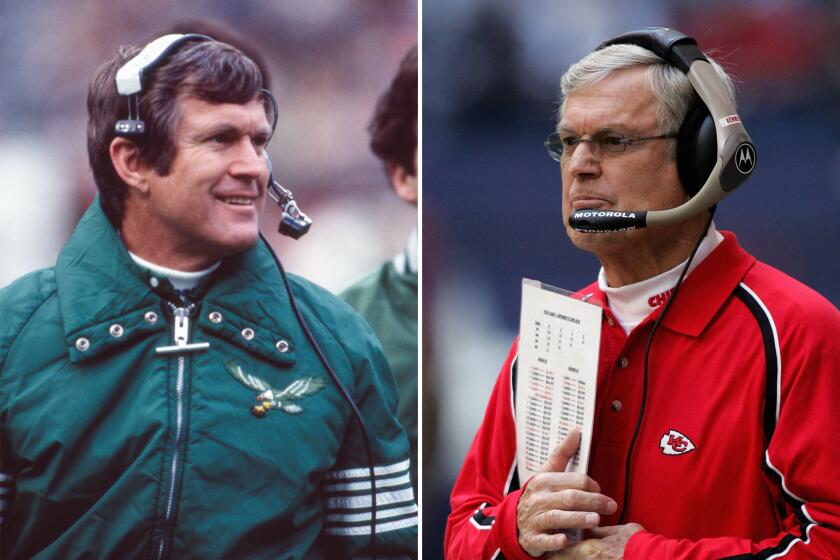TV Violence Rouses the Old Itch to Censor : Drawn from a spectrum of motives and politics, the critics would rerun the paranoid ‘50s.
- Share via
When the Chicago Bulls won their third world championship, riots broke out in Chicago, killing three people. When the Montreal Canadiens took the Stanley Cup, the ensuing riots injured 168 and did $10 million in damage. The Dallas Cowboys’ Super Bowl victory produced similar results.
You do not have to be a social scientist to see the relation. Sports championships cause violence.
But calling for an end to the Super Bowl or the NBA championship games will not win politicians the applause of journalists and social critics. Dragging Michael Jordan in front of a Senate committee and demanding that he justify his profession will not make Sen. Paul Simon any friends back home in Illinois.
Denouncing television violence will. From Sen. Estes Kefauver in the 1950s on, politicians with a love for the nanny state and an instinct for the spotlight have decried TV violence to attract the cameras to themselves.
The networks’ recent agreement to put warning labels on particularly violent shows will not end the calls for censorship. Sen. Byron Dorgan (D-N.D.) says the warnings are “like having a chemical company paint their smokestack red to say here’s where the pollution is being emitted.” Pat Buchanan says the 1st Amendment doesn’t protect “cultural pollution.” And Michigan gadfly Terry Rakolta still wants the Federal Communications Commission to ban “violent” programming from 4 p.m. to 9 p.m. Interim FCC Chairman Jim Quello supports her proposal.
The “problem” of TV violence is not a problem of uninformed viewers. People did not tune in “Murder in the Heartland” expecting “Little House on the Prairie.” Roseanne hasn’t suddenly started taking a hatchet to her sit-com kids. The problem, in the minds of critics, is that television violence exists at all.
That is why the critics are never satisfied. If TV violence is realistic, as in reality cop shows, they complain that it leads people to think the world is threatening. If it is unrealistic, as in cartoons, they complain that it is desensitizing. If violence is portrayed as painful or bloody, they complain about gore. If it is portrayed as clean, complain about trivialization.
They disdain both the nihilistic “Murder in the Heartland” and the moral “Wiseguy.” If villains use violence to hurt people, critics gripe about bad role models. If heroes use violence to save people, they’re teaching that violence solves problems, critics say.
If broadcasters propose a warning for parents that a show may be inappropriate for children, critics say the parents may not be around. If parents are around, what about kids who have their own TV sets in their bedrooms? And if a family has no TV at all, what about kids watching violent shows at friends’ houses?
These are not arguments for more parental information. They are arguments for banning art. And we have heard them before.
Back in the 1950s, when Kefauver, a Tennessee Democrat and vice-presidential aspirant, was not crusading against television, he was crusading against comic books. Inspired by Dr. Fredric Wertham’s 1953 book, “Seduction of the Innocent (now a touchstone example of overwrought Eisenhower-era fears of sex, violence and social deviance), Kefauver held hearings to bully the comic book industry into “doing something” about the problem of crime comics and comics-inspired juvenile delinquency. Comics, it was argued, were uniquely pervasive and uncontrollable by parents.
In response, the industry created the Comics Code, wiping out all adult comics. For the next two decades, comic books were utterly banal. An entire genre, the serous graphic novel, was destroyed, the good with the bad. In the name of children, and a small minority of violent children at that, the freedom of nonviolent adults to read, write, draw and publish was obliterated.
That is what the critics of television violence are driving toward. Some, like the National Coalition on Television Violence, are ideological pacifists. Some, like Buchanan or Michael Medved, are conservatives at war with popular culture. Some, like Rakolta, are meddlesome moms. Some watch television; most do not.
Their motives and ideologies are different. But all seek to use the official violence of government power to wipe out ideas and images they do not like. They say those ideas and images inspire crimes. So do love and hate, religion and politics. So, even, do national basketball championships.
But in a free society we distinguish between ideas and actions. And we do not sacrifice the artistic and commercial freedom of the many to the violent acts--or political posturing--of the few.
More to Read
Go beyond the scoreboard
Get the latest on L.A.'s teams in the daily Sports Report newsletter.
You may occasionally receive promotional content from the Los Angeles Times.










